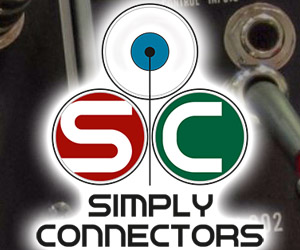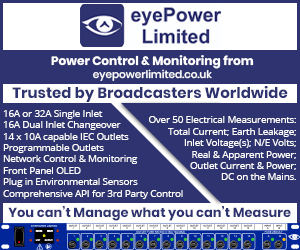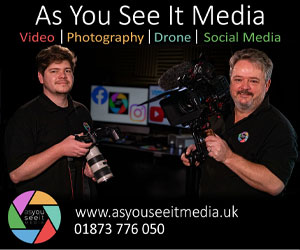Broadcast News
13/09/2016
Fibre Optic Brief

Fibre optic links have now been in use for many wears in the commercial/military field. Primarily in the military field for security as it does not radiate and the commercial field for its greater link spans and high data rates, writes William Saich, Volamp.
As it is now becoming increasingly used in the broadcast industry this article is intended to give an understanding of the various items and terms used.
There are many excellent articles which cover how light propagates down fibres. I shall not go into any great detail on the physics, but just give information which may be of interest and use.
The "light" can be at different wave lengths dependant on materials. These can go simultaneously and independently down a single fibre so we can increase the capacity without having to put in multiple fibres. The "light" has a wavelength of approximatively 1200 to 1600nm; spacing is usually 20nm, referred to as CWDM (course wave length division multiplexing). A more expensive 10nm spacing can be used DWDM (dense). This "light" generation requires laser transmitters. Some Ethernet is at 850nm which can then use LEDs and is visible longer.
It is also possible to transmit in one direction at one wavelength and a different wavelength in the other "BIDI", so you get full duplex with one fibre. An example of CWDM and BIDI is in the Volamp Camlinx camera back systems.
At one time there was a lot of different fibres and connectors used, but now for the broadcast industry the most common cable Single Mode (SM), which has a core of 9 microns hair is about 70. The data world is normally 62.5 microns, both fibres are 125 micron diameter.
The attenuation down SM fibre is very low. The difference between a short cable, say 100m, and 1km, will not cause a problem. Dirt or damaged ends will be far more likely be the culprit.
This does allow similar connectors for data and video, but of course video must be more controlled. The transmitters/receivers are now much simplified and readily available as a module (SFP), but there is one major difference with video SFPs and data types which is due to the coding used. The data in both cases starts of as NRZ (non return to zero). This must be encoded for fibre or ac coupled links. Ethernet uses a coding which results in a 25% increase in data rate; this is then scrambled for copper to reduce EMC, but not scrambled for fibre.
SMPTE just scrambles, but this results in difficulties with certain patterns, so-called Pathological.Data types will error with these .net result. You have to use a video type which costs five times as much. There is negligible internal difference in the SFPs. It is put down to quantity. I hope SMPTE recognise this and code such that the higher rates can be implemented with data SFPs which are already available. One warning; due to lack of standardization with video SFPs, it is possible that a high output transmitter will overload a receiver. The data types come under a Multi Source Agreement (MSA) which specifies maximum power.
For the simple non-rugged connections, then the LC connector, as standardised in the data industry, is the most common, although you may come across SC (LC's big brother) or ST. Over the last few years, there have been many different types introduced (100).
The broadcast and military require a rugged connector. This has been implemented using LC connectors or fibre ferrules in rugged housings. The big advantage of the LC approach is that it is inexpensive and readily repairable.
A camera can also be powered by using cable which also has copper conductors (hybrid). The higher the voltage, the greater the distance. If the voltage is under the low voltage directive then this will avoid power interlocks generally using a couple of copper conductors.
The hybrid connectors are relatively expensive and some suppliers are restrictive regarding manufacture and repair. The two most used camera connectors are the LEMO with ferrules and Neutrik based on LC's. Volamp has introduced a hybrid system in which the fibre is an inexpensive rugged connector, also based on LC, and the cable is Y split with a separate power connector. The result is a relatively inexpensive, rugged cable.
These are all butt connectors and must be incredibly accurately aligned and kept clean as core of fibre (9 microns for SM) is about one eighth the diameter of hair.
An alternative is expanded beam connectors; the effective diameter is increased by lenses. These are very expensive and most likely seen on military equipment. The angular error is now critical. They will have a higher insertion loss, but it is consistent and they are easy to clean.
This is written from a practical viewpoint to help understand fibre links, I hope it is of use.
www.volamp.com
This article is also available to read at BFV online here, page 58.
(JP/LM)
As it is now becoming increasingly used in the broadcast industry this article is intended to give an understanding of the various items and terms used.
There are many excellent articles which cover how light propagates down fibres. I shall not go into any great detail on the physics, but just give information which may be of interest and use.
The "light" can be at different wave lengths dependant on materials. These can go simultaneously and independently down a single fibre so we can increase the capacity without having to put in multiple fibres. The "light" has a wavelength of approximatively 1200 to 1600nm; spacing is usually 20nm, referred to as CWDM (course wave length division multiplexing). A more expensive 10nm spacing can be used DWDM (dense). This "light" generation requires laser transmitters. Some Ethernet is at 850nm which can then use LEDs and is visible longer.
It is also possible to transmit in one direction at one wavelength and a different wavelength in the other "BIDI", so you get full duplex with one fibre. An example of CWDM and BIDI is in the Volamp Camlinx camera back systems.
At one time there was a lot of different fibres and connectors used, but now for the broadcast industry the most common cable Single Mode (SM), which has a core of 9 microns hair is about 70. The data world is normally 62.5 microns, both fibres are 125 micron diameter.
The attenuation down SM fibre is very low. The difference between a short cable, say 100m, and 1km, will not cause a problem. Dirt or damaged ends will be far more likely be the culprit.
This does allow similar connectors for data and video, but of course video must be more controlled. The transmitters/receivers are now much simplified and readily available as a module (SFP), but there is one major difference with video SFPs and data types which is due to the coding used. The data in both cases starts of as NRZ (non return to zero). This must be encoded for fibre or ac coupled links. Ethernet uses a coding which results in a 25% increase in data rate; this is then scrambled for copper to reduce EMC, but not scrambled for fibre.
SMPTE just scrambles, but this results in difficulties with certain patterns, so-called Pathological.Data types will error with these .net result. You have to use a video type which costs five times as much. There is negligible internal difference in the SFPs. It is put down to quantity. I hope SMPTE recognise this and code such that the higher rates can be implemented with data SFPs which are already available. One warning; due to lack of standardization with video SFPs, it is possible that a high output transmitter will overload a receiver. The data types come under a Multi Source Agreement (MSA) which specifies maximum power.
For the simple non-rugged connections, then the LC connector, as standardised in the data industry, is the most common, although you may come across SC (LC's big brother) or ST. Over the last few years, there have been many different types introduced (100).
The broadcast and military require a rugged connector. This has been implemented using LC connectors or fibre ferrules in rugged housings. The big advantage of the LC approach is that it is inexpensive and readily repairable.
A camera can also be powered by using cable which also has copper conductors (hybrid). The higher the voltage, the greater the distance. If the voltage is under the low voltage directive then this will avoid power interlocks generally using a couple of copper conductors.
The hybrid connectors are relatively expensive and some suppliers are restrictive regarding manufacture and repair. The two most used camera connectors are the LEMO with ferrules and Neutrik based on LC's. Volamp has introduced a hybrid system in which the fibre is an inexpensive rugged connector, also based on LC, and the cable is Y split with a separate power connector. The result is a relatively inexpensive, rugged cable.
These are all butt connectors and must be incredibly accurately aligned and kept clean as core of fibre (9 microns for SM) is about one eighth the diameter of hair.
An alternative is expanded beam connectors; the effective diameter is increased by lenses. These are very expensive and most likely seen on military equipment. The angular error is now critical. They will have a higher insertion loss, but it is consistent and they are easy to clean.
This is written from a practical viewpoint to help understand fibre links, I hope it is of use.
www.volamp.com
This article is also available to read at BFV online here, page 58.
(JP/LM)
More Broadcast Equipment Stories
29/03/2019
360 Video Equipment
TX uses the widest possible range of 360 Degree Video Camera Systems to allow users to choose the perfect camera for their application, even in the ha
360 Video Equipment
TX uses the widest possible range of 360 Degree Video Camera Systems to allow users to choose the perfect camera for their application, even in the ha
11/06/2018
BFV's Big Interview: Finepoint Broadcast
Broadcast Film & Video exclusively talks to Giles Bendig, the Managing Director of Finepoint Broadcast. The firm has been supplying broadcasters with
BFV's Big Interview: Finepoint Broadcast
Broadcast Film & Video exclusively talks to Giles Bendig, the Managing Director of Finepoint Broadcast. The firm has been supplying broadcasters with
27/02/2018
BFV's Big Interview: TSL Products
For more than 30 years, TSL Products has worked directly with the world's leading broadcasters and content creators to design, manufacture and market
BFV's Big Interview: TSL Products
For more than 30 years, TSL Products has worked directly with the world's leading broadcasters and content creators to design, manufacture and market
14/12/2017
Camera Automation For Sky Sports' PDC Darts Championships Coverage
MRMC has been providing robotic systems for Sky Sports' coverage of the PDC darts championships for three years. Between the 2013 2016 seasons, the ro
Camera Automation For Sky Sports' PDC Darts Championships Coverage
MRMC has been providing robotic systems for Sky Sports' coverage of the PDC darts championships for three years. Between the 2013 2016 seasons, the ro
16/06/2017
BFV's Big Interview: Vortex
Based in Ealing, London, Vortex Communications has been delivering cost-effective solutions to broadcast and professional AV users since 1987. This mo
BFV's Big Interview: Vortex
Based in Ealing, London, Vortex Communications has been delivering cost-effective solutions to broadcast and professional AV users since 1987. This mo
14/06/2017
Tally Technologies Introduce TallyTec Pro
Tally Technologies has introduced the TallyTec Pro – a tally light and timecode transmission system designed for the professional live production mark
Tally Technologies Introduce TallyTec Pro
Tally Technologies has introduced the TallyTec Pro – a tally light and timecode transmission system designed for the professional live production mark
23/01/2017
Getting The Most Out Of Fibre
Thanks to its ability to transport broadcast signals quickly and smoothly over very long distances – much longer than copper – fibre has become as muc
Getting The Most Out Of Fibre
Thanks to its ability to transport broadcast signals quickly and smoothly over very long distances – much longer than copper – fibre has become as muc
20/01/2017
AJA Ships ROI-SDI Scan Converter
AJA Video Systems has started shipping its ROI-SDI scan converter. Bringing Region-of-Interest (ROI) controls for professional SDI sources into a port
AJA Ships ROI-SDI Scan Converter
AJA Video Systems has started shipping its ROI-SDI scan converter. Bringing Region-of-Interest (ROI) controls for professional SDI sources into a port
16/01/2017
Hamlet And Good To Go!
Hamlet had a successful 2016 with a great response to its latest modular matrix switch range launched at IBC. The Hamlet portables for base band and s
Hamlet And Good To Go!
Hamlet had a successful 2016 with a great response to its latest modular matrix switch range launched at IBC. The Hamlet portables for base band and s
16/01/2017
How To Use Autocue Effectively
Autocue, teleprompting, prompting. Rarely the first service on the production managers list, and yet, it's a piece of equipment which when paired with
How To Use Autocue Effectively
Autocue, teleprompting, prompting. Rarely the first service on the production managers list, and yet, it's a piece of equipment which when paired with















